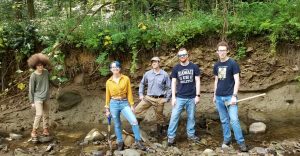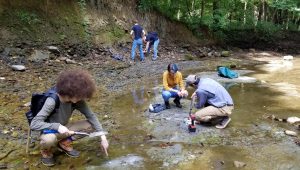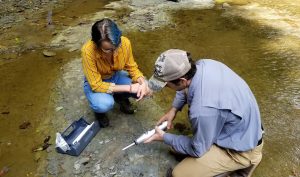
The class stands in front of one of the unconformities in Wooster Memorial Park (aka Spangler). There was some discussion if this is a disconformity (yes) or a nonconformity (maybe yes). The lodgment till at the base is overlain by a fluvial gravel. The high relief of the contact is due to high mineralization – iron, manganese and other oxides; interestingly many of the clasts were coated with over a centimeter-thick rind.

Two class members (in the distance) work on the fluvial sediments sitting on top of the Mississippian bedrock. This is the Great Unconformity in the Spangler Gorge. The Fluvial sediments are capped with mill pond (legacy) sediments. Others drill in stainless steel erosion pins into the bedrock channel. Morgan in the foreground points one of the pins out.

Evan examines a debris flow that moved into the fluvial point bars sediments. He found organics in the flow and we have sent wood samples out for radiocarbon analysis. Results are pending, but they will give us information on the geologic evolution of the gorge.

The Schmidt Hammer is being armed as a way to measure rock strength. Several measurements of the bedrock will be taken to “map out” the relative rock strength of the gorge floor (bedrock stream).
